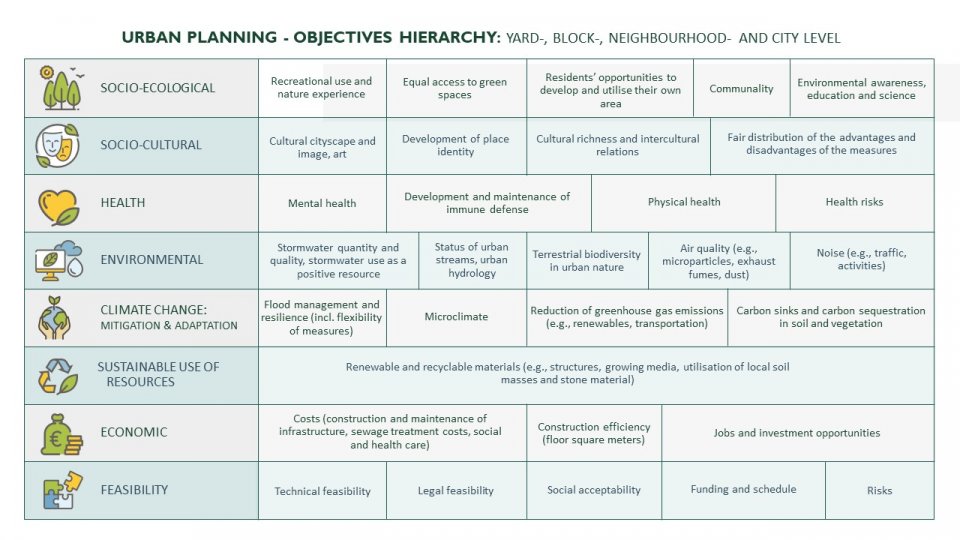
A new residential area (600 hectare) of 45,000 inhabitants is planned as a part of the Kivistö suburbian in the City of Vantaa (pop. 241 000). The target area of this study was 20 hectares of this larger entity.
A central part of stormwater management is building a reservoir (ca 1 hectare) for the retention of the flood water. Designing the options was an iterative task and it was guided by the objectives presented in the evaluation framework.
The objectives of the case were to i) develop a systematic and interactive approach to support multi-objective urban planning in general and ii) to demonstrate the approach in the Kivistö sketch area in developing and evaluating alternatives for urban planning and decentralised stormwater management.
The starting point for the planning of the center of Kivistö is climate change mitigation and adaptation, as well as the city of Vantaa's goal to be carbon neutral by 2030.
Designing the options was an iterative task and it was guided by the objectives presented in the evaluation framework. The alternatives were: (A) A natural-like wetland park-like for storm water storage with more forest and urban farming opportunities and lower construction efficiency than in the second option. (B) A functional option consisting of several pools, where the purposes of using the pools, which are dry most of the time, were related to various hobbies of children and young people, for example skating and basketball. The options differed in terms of the size of the built area and amount and location of green areas. The water storage capacity was about the same.
We developed an evaluation framework in an intense dialogue with city planners. Altogether a dozen meetings were held. In addition, a workshop for different sectors’ planners and experts in the City of Vantaa was organised. The framework was used in the development of alternatives and their multi-criteria evaluation. We have adopted co-design approaches and multicriteria decision analysis (MDCA) in assessing stormwater management scenarios for the stormwater park in Kivistö.
Multicriteria decision analysis (MCDA):
• provides a systematic framework for planning and discussions,
• supports forming a synthesis of the available information and helps to identify information gaps and uncertainties,
• promotes the learning and comprehensive understanding of the planning situation of those participating in the process,
• supports the systematic and transparent formation and evaluation of alternatives,
• accelerated and structured discussions in a group with representatives of several different stakeholders and
• at best promoted the finding of sustainable solutions acceptable to different parties.
- Developing climate change adaptation; improving risk management and resilience
- Flood peak reduction
- Increase infiltration / Water storage
- Increasing infiltration
- Reduce flood risk
- Reduce run-off
- Enhancing sustainable urbanisation
MCDA is a generic method which can be applied in different types of environmental planning cases where there is need to improve communication between different parties and systematically develop and evaluate alternatives having incommensurable impacts. The benefits of collaborative MCDA have been reported widely, and the results have been very similar,
To ensure that analyses are not superficial and important perspectives are overlooked, it is important that experts from different sectors are involved in the evaluation. Essential objectives should be identified at an early stage. Otherwise, there is a risk of 'missing the forest for the trees' or the phenomenon of 'analysis paralysis' due to too many objectives
Academy of Finland (decision number 326851, ATeNaS)
ATeNaS project “To Ally Technology, Nature and Society for integrated urban water management” funded under the program WaterWorks2017 of JPI Water
City of Vantaa
MCDA framework
The framework supported the discussion between experts, enabled a more in-depth discussion than usual about the objectives to be taken into account in planning and their appearance in the plans. The approach also contributed to the development of a more comprehensive perspective and thus supports breaking away from silo-like planning in large organisations like the City of Vantaa. In addition, the framework helped the planners to find new solutions that supported multiple objectives.
The application of MCDA so that the focus was on the objectives and on the development of alternatives and their general comparison proved to be a good solution. Typically the main outcome is the ranking of alternatives. It is essential that experts from different sectors are engaged in the evaluation. Otherwise, the analysis may remain superficial and important perspectives may be overlooked. It is also useful from a learning point of view that the participants hear the views of experts from various fields.
Since the framework contains a large number of different types of objectives, going through all the objectives together was laborous. The danger in extensive and comprehensive analysis, such as the Kivistö case, is that too much time is spent on the initial structuring and discussions relative to the total available time and human resources. That's why the essential objectives should be identified at an early stage and the less relevant ones should be delineated.


